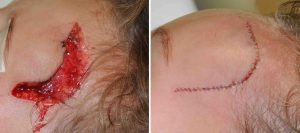
Having done many hundreds of facial dogbite repairs and secondary reconstruction, there are some very common trends. A disproportionate number occur in children from ages five to nine, the biting dog is rarely an unknown one, and many such injuries turn into legal and insurance issues. The common age of patient injury is a reflection of the naïve and innocent nature of that age and their view that dogs are playful and fun. Most dogbites occur in a family, neighbor or relative’s dog where the familiarity promotes unintentional behaviors that are predisposed to evoke their protective natures. Because many dogbites occur on the owner’s home, insurance battles are certain to ensue that frequently involve lawyers. It is not uncommon for me to see referrals from attorneys to evaluate dogbite scars and get an estimate on the cost of scar revision.
That being said, prevention of dogbite injuries can avoid many of these problems. These are the most significant ways to avoid a dogbite injury to a child. These are based on many of the reasons or circumstances I have heard that were given for what was going on when the injury happened.
1) Don’t play aggressive games with a dog. They may not see it as a game.
2) Don’t mess with a dog while eating or play keep away games with food. They are very protective of food and aggressive about getting it.
3) Do not jump on a sleeping dog or surprise it from behind. Give it plenty of warning that you are around.
4) Do not attempt to kiss a dog, particularly face-to-face. Dogs tend to strike defensively when confronted directly.
5) Do not hug, squeeze, or ‘pin’ a dog in any way. This is likely not to be interpreted as play to them.
6) Keep away from a dog with puppies or do not attempt to take a puppy away or get between a mother and her puppy.
7) Do not attempt to pet a dog, particularly an unfamiliar one, unless you let them sniff you first.
While some dogbites can just not be prevented or occur for no discernible reason, these behaviors which are common in children can unintentionally cause a defensive maneuver by a dog. Defensive maneuvers in dogs are usually a biting response and their nature is to go for the face and neck.
Dr. Barry Eppley
Indianapolis, Indiana


